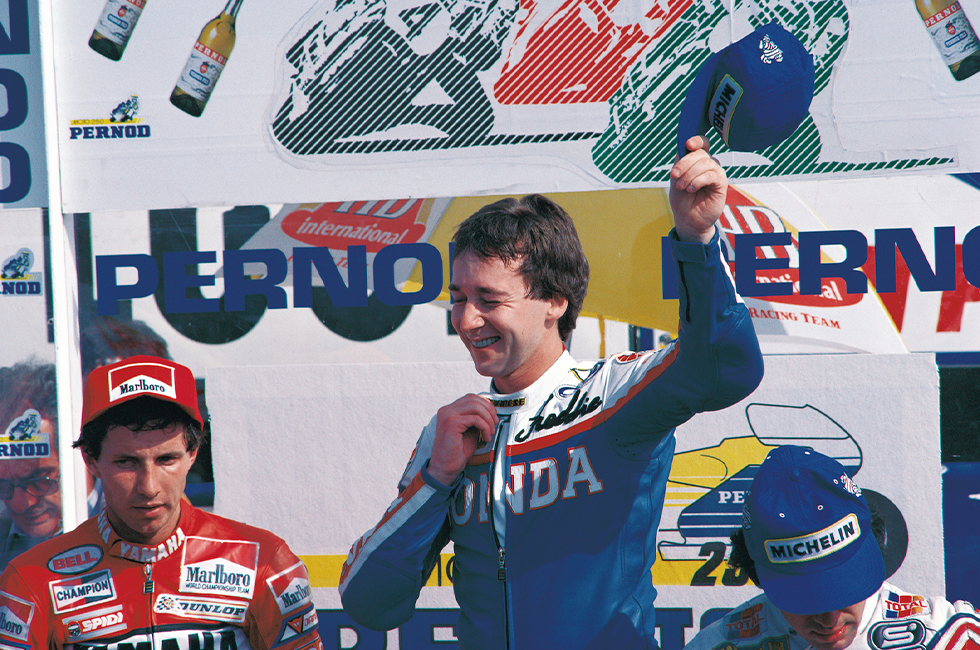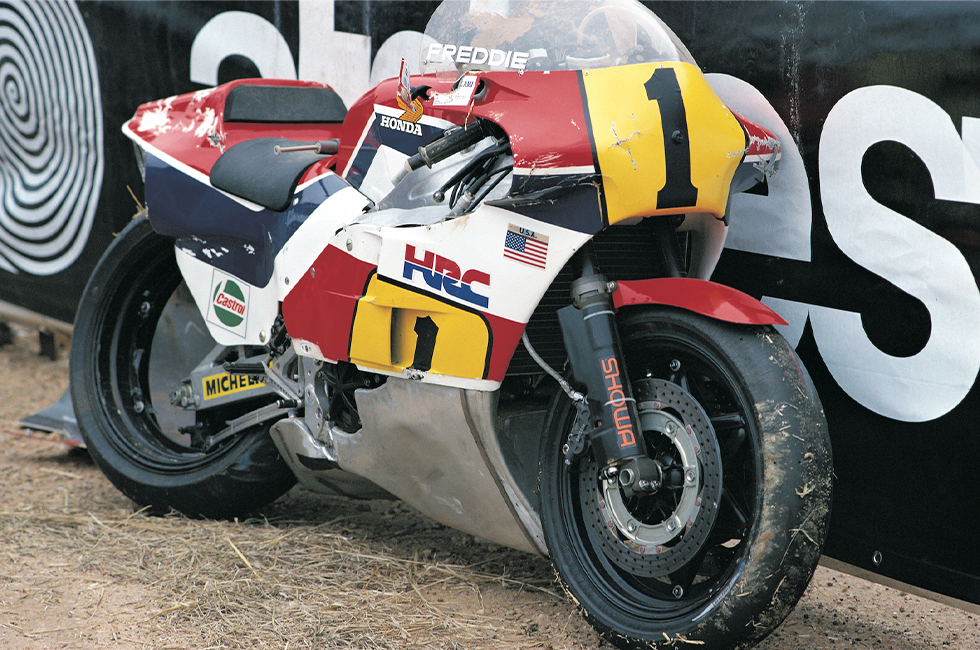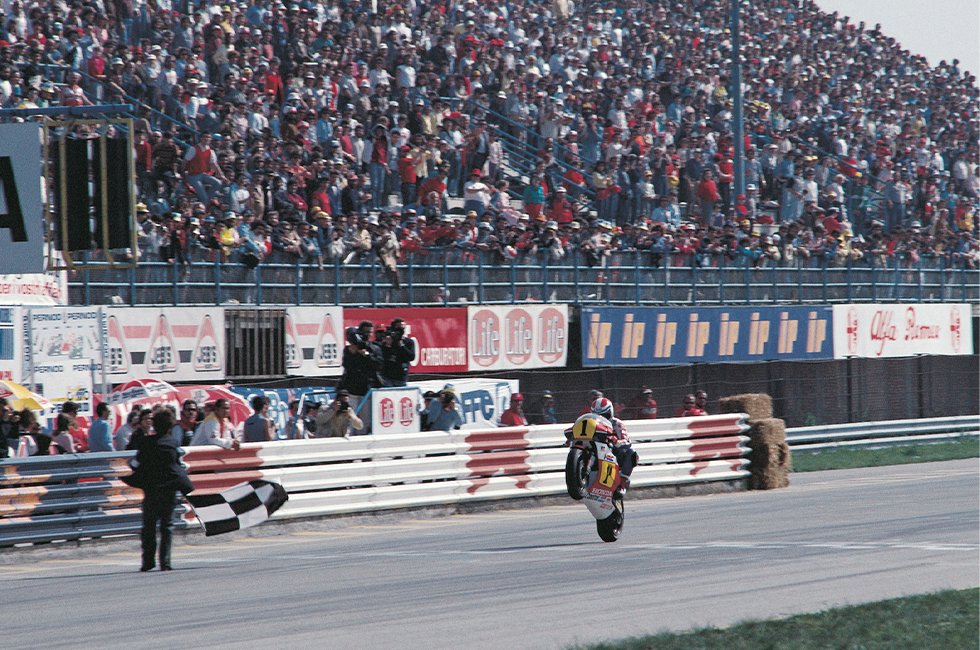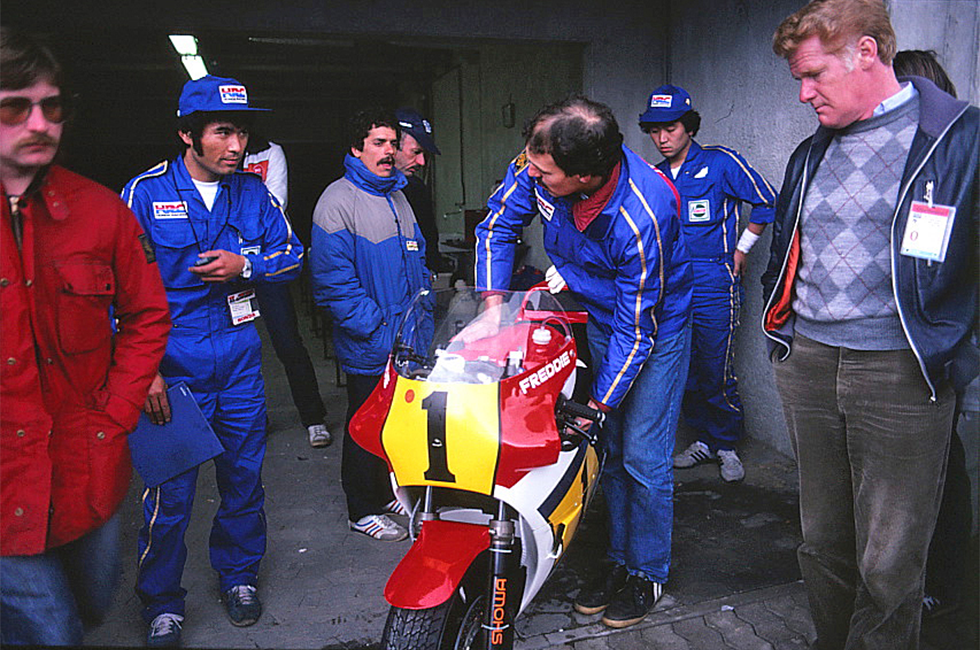The NV0A achieved its first victory in the second Grand Prix, but hardships lay ahead.

The first victory in the NSR500 series' 19-year history came in 1984 at the second round of the World Championship, the Italian GP. In the center of the photo is Spencer, who took the solo victory on the NV0A and is receiving congratulations on the podium. On the left of the image is Yamaha's Eddie Lawson, who finished 2nd. (Photo/Shigeo Kibiki)
Two weeks after Daytona, the FIM Road Racing World Championship started at the Kyalami Circuit in South Africa. During the first qualifying session at the first round of the series, the rear wheel of the NV0A shattered, which caused Spencer an unexpected fall that damaged ligaments in his right ankle and cracked his left little toe, forcing him to miss the first race of the season as the defending champion.

The NV0A suffered a broken rear wheel and crashed during the first qualifying session for the South African GP. (Photo/Shigeo Kibiki)
HRC's road racers at the time used the Comstar wheels, which were Honda's unique assembly wheels. The NV0A's wheel rim and spoke plate were unique parts made of CFRP. Although HRC had been using these carbon Comstar wheels since the previous generation, NS500, there was speculation that it could not withstand the increased power of the NSR500's V4 engine and thus broke. However, even at racing speeds, there is no way HRC would approve using parts that would break under the load applied during regular running.
The damaged wheel was also used at the previous Daytona. There was a moment when the machine went into a high-side situation and was overloaded; however, it continued to be used after that. HRC's analysis was that the damage may have progressed and broken when it reached South Africa.
After recovering from his injury, Spencer competed safely in the Italian GP three weeks later. Of course, he used the NV0A. Moreover, Spencer took the first NSR500 victory in a pole-to-finish fashion. In the qualifying session, he recorded a time that beat out second place by 1.72 seconds, and in the final, he achieved a landslide victory with a lead of nearly 20 seconds over the runner-up.

The first time the NSR500 raced in the final of the World Championship was the 1984 Italian GP. Spencer won the race with an overwhelming command and took the checkered flag with a high wheelie on his NV0A. (Photo/Shigeo Kibiki)
At this point, only some people doubted the potential of the upside-down layout. But soon, dark clouds began to gather.
First, there was an accident in which Spencer broke both of his little toes. His injury was caused by a fall in the Transatlantic Anglo-American Match Race in which he participated with the NV0A after the Italian GP. This injury forced Spencer to miss the Spanish GP, the third round of the series.
Spencer returned at the fourth round, the Austrian GP, held at Salzburgring, but his NV0A did not run as expected this time. The main problem was with the carburetor settings. The NV0A's carburetors for four cylinders are lined up in a horizontal line, but all the carburetors are located in a place surrounded by the engine and four chambers. Therefore, the temperature of the air that is inhaled becomes high. In other words, you will inhale with a slightly lower oxygen concentration.
Additionally, there was a difference in intake air temperature between the two outer cylinders and the two inner cylinders of the horizontally arranged carburetor, and there was a difference of two to three ranks in terms of the main jet. Then, when they came to Salzburgring, where the altitude was high and oxygen was thin, the inherent difficulty of setting the NV0A's carburetor was exacerbated. They could only reach speeds that could be easily overtaken by a 3-cylinder NS500 on a straight section.
At this Austrian GP, Spencer ended up finishing in 2nd place after Randy Mamola, his teammate ahead of him, gave up his position. However, Nurburgring, the venue for the next race, the West German GP, was also at a high elevation. Spencer rode the NV0A for Friday's session there, but as expected, things didn't go as well as he had hoped. That made him want to switch to the NS500 for this race. HRC was forced to make a difficult decision but accepted the ace rider's earnest request.
However, since the plan was to run the NV0A throughout the season, there was no NS500 available for Spencer on site. So, on Friday night, HRC staff drove a van from the Nurburgring to Aalst, Belgium, where HRC's European base is located. They picked up the NS500 sleeping in the workshop and returned to the Nurburgring by dawn on Saturday, in time for the qualifying session.

The NS500, which had been brought in from Belgium in a hurry, was on standby in the HRC pit on Saturday morning at the West German GP. (Photo/Jiro Ishida)
Spencer rode a 3-cylinder machine for the first time after finishing the previous season. Still, he set the fastest time, took pole position, and won the next day's race alone on the NS500.
Spencer won the race. However, it was not an engineering victory. That was the mindset of the HRC staff.






